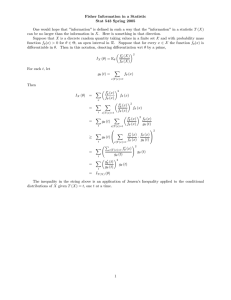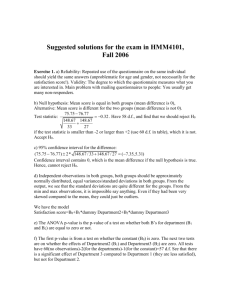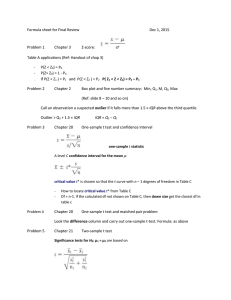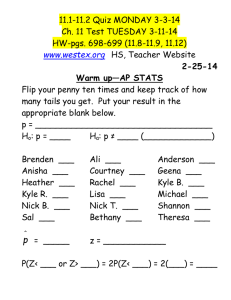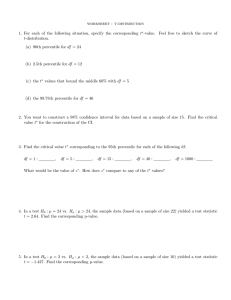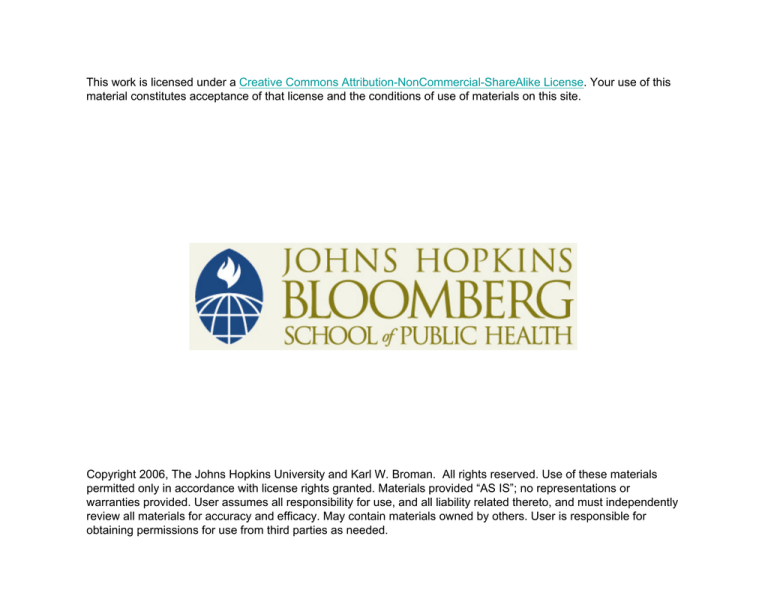
This work is licensed under a Creative Commons Attribution-NonCommercial-ShareAlike License. Your use of this
material constitutes acceptance of that license and the conditions of use of materials on this site.
Copyright 2006, The Johns Hopkins University and Karl W. Broman. All rights reserved. Use of these materials
permitted only in accordance with license rights granted. Materials provided “AS IS”; no representations or
warranties provided. User assumes all responsibility for use, and all liability related thereto, and must independently
review all materials for accuracy and efficacy. May contain materials owned by others. User is responsible for
obtaining permissions for use from third parties as needed.
ANOVA, still
{Yti} independent with Yti ∼ normal(µt, σ) for t = 1 . . . k.
Test H0 : µ1 = µ2 = · · · = µk
The usual statistic:
P
2
t nt (Ȳt· − Ȳ··) /k
P
F = MB/MW = P P
2/(
(
Y
−
Ȳ
)
t·
t nt − k)
t
i ti
P-values:
(a) Use the F(k,
P
nt − k) distribution.
(b) Use a permutation test.
Assumptions:
(a) Underlying dist’ns are normal with common SD.
(b) Underlying dist’ns are the same.
Non-parametric ANOVA
An alternative approach: the Kruskal-Wallis test.
Rank all of the observations from 1, 2, . . . , N.
Let Rti = the rank for observation Yti.
P
Let R̄t· = i Rti/nt = the average rank for group t.
Null hypothesis, H0: the underlying distributions are all the same.
E(R̄t· | H0) =
N+1
2
SD(R̄t· | H0) =
q
(N+1) (N−nt)
12 nt
Kruskal-Wallis test statistic
H =
X N − nt t
N
×
R̄t· − E(R̄t· | H0)
SD(R̄t· | H0)
2
2
X N+1
12
nt R̄t· −
= ···=
N (N + 1)
2
t
Under H0, and if the sample sizes are large, H ∼ χ2(df = k – 1).
Alternatively, we could use a permutation test to estimate a Pvalue.
The function kruskal.test() in R will calculate the statistic.
Note
In the case of two groups, the Kruskal-Wallis test reduces exactly
to the Wilcoxon rank-sum test.
This is just like how ANOVA is equivalent to the two-sample t test.
A
B6
1
2
4
5
6
7
8
10
11
12
13
14
15
17
18
19
24
25
26
Strain
Strain
Example
0
1000
2000
3000
4000
5000
A
B6
1
2
4
5
6
7
8
10
11
12
13
14
15
17
18
19
24
25
26
6000
2.5
IL10 response
3.0
3.5
log10 IL10 response
ANOVA Tables
Original scale / 1000:
source
between strains
within strains
total
SS
df MS
F P-value
33 20 1.69 1.70
0.042
124 125 0.99
157 145
permutation P-value = 0.043
log10 scale:
source
between strains
within strains
total
SS
df
MS
F
P
3.35 20 0.167 2.25 0.0036
9.29 125 0.074
12.63 145
permutation P-value = 0.003
K-W results
The observed Kruskal-Wallis statistic for these data was 41.32.
(Note that it doesn’t matter whether you take logs.)
Since there were 21 strains, we can compare this to a χ2 distribution with 20 degrees of freedom. Thus we obtain the P-value =
0.003.
With a permutation test, I got P̂ = 0.0015 (on the basis of 10,000
simulations.
In the case of ties...
In the case of ties, we assign the average rank to each.
Example:
A:
3.5
3.7
4.0 4.2
B:
3.9
C: 3.1
3.6
4.0
4.3
4.3
4.3
4.5
(1) (2) (3) (4) (5) (6/7) (8) (9/10/11) (12)
↓
↓
6.5
10
Then we apply a correction factor.
Let N =
P
t nt
and Ti = no. observations in the ith set of ties (can be 1).
Let D = 1 –
Use the statistic
P
i(Ti
3
− Ti)/(N3 − N)
H′ = H/D.
Note that D ≤ 1 and so H′ ≥ H.
For the example, D = 1 –
(23 −2)+(33 −3)
123 −12
≈ 0.983.
Blood coagulation time
Diet A
Diet B
Diet C
Diet D
Combined
56
57
58
59
60
61
62
63
64
65
66
67
coagulation time
Example (continued)
A
B
C
D
56
59
59
60
60
61
62
62
63
63
63
63
64
64
65
66
66
67
67
68
68
68
71
71
rank
1
2
3
4
5
6
7
8
9
10
11
12
13
14
15
16
17
18
19
20
21
22
23
24
avg rank
1
2.5
2.5
4.5
4.5
6
7.5
7.5
10.5
10.5
10.5
10.5
13.5
13.5
15
16.5
16.5
18.5
18.5
21
21
21
23.5
23.5
68
69
70
71
72
Example (continued)
A
B
C
D
62
60
63
59
61
7.5
4.5 10.5
2.5
6.25
63
67
64
66
66
10.5 18.5 23.5 13.5 15.0 16.5
16.25
68
71
66
71
67
65
68
68
68
21.0 16.5 23.5 18.5 21.0 21.0
20.25
56
62
60
61
63
64
63
59
61
1.0
7.5
4.5
6.0 10.5 13.5 10.5
2.5
7.00
Calculation of K-W test statistic
A
B
C
D
4
6
6
8
6.25 16.25 20.25 7.00
nt
R̄t·
H =
=
12
N (N+1)
12
24×25
= 16.86
P
t
nt R̄t· −
N+1
2
N = 24
N+1
2 = 12.5
2
2
2
4 × (6.25 − 12.5) + · · · + 8 × (7.00 − 12.5)
The ties: Ti = ( 1 2 2 1 2 4 2 1 2 2 3 2 )
P
D = 1 – i(T3i − Ti)/(N3 − N) = . . . = 0.991
H′ = H/D = 16.86 / 0.991 = 17.02
[df = 3]
P-value ≈ 0.0007
A few points
• Calculation of P-values: (avoiding type I errors)
– F statistic: F distribution (requires normality)
– K-W statistic: χ2 distribution (requires large samples)
– Either statistic: Permutation tests
• Power: (avoiding type II errors)
– K-W statistic more resistant to outliers
– F statistic more powerful in the case of normality
• K-W statistic: don’t need to worry about transformations.
A fake example
Dataset A
Dataset B
C
C
B
B
A
A
30
35
40
45
50
30
35
40
45
50
Results
nominal
Permu’n
Dataset
Method
Statistic
P-value
P-value
A
ANOVA
5.48
0.020
0.017
K-W
7.64
0.022
0.012
ANOVA
2.64
0.112
0.023
K-W
7.64
0.022
0.012
B
Distributions
ANOVA
Dataset A
0
2
4
6
8
ANOVA
Dataset B
10
12
0
1
F statistic
2
F statistic
K−W test
0
3
2
4
6
K−W statistic
8
10
4
5




